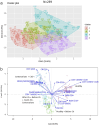Multivariate analysis of immunosenescence data in healthy humans and diverse diseases
- PMID: 40308557
- PMCID: PMC12040824
- DOI: 10.3389/fragi.2025.1568034
Multivariate analysis of immunosenescence data in healthy humans and diverse diseases
Abstract
Introduction: Immunosenescence is a dynamic process, where both genetic and environmental factors account for the substantial inter-individual variability. This paper integrates all the data on immunosenescence markers generated in our laboratory and describes the differences and/or similarities between individuals based on their biological conditions (immunosenescence markers) and their associations with chronological age and health status.
Materials and methods: The dataset consisted of immunological data from healthy donors, centenarians, patients diagnosed with chronic kidney disease, COVID-19 and non-small cell lung cancer (NSCLC), treatment-naïve or treated with platinum-based chemotherapy. To determine whether there are groups of immunologically different individuals despite their age or clinical condition, cluster analysis was performed. Canonical discriminant analysis was performed to determine which variables characterize each cluster.
Results: There are differences in the expression of immunosenescence markers between healthy subjects and patients diagnosed with different pathological conditions, regardless of their age. Meanwhile, the distribution of the clusters indicates the presence of two separate groups of healthy participants, one of them characterized by a high frequency of naïve lymphocytes, and the other with high expression of terminally differentiated lymphocyte subsets. Advanced NSCLC treatment-naïve patients were in the same cluster as a group of healthy subjects. Additionally, centenarians belong to a different cluster than healthy subjects, suggesting they might have a unique immune signature.
Conclusion: The distribution of clusters appears to be more appropriate than univariate associations of single markers for health and disease research. The present work reveals which immune markers are relevant in different physiological and pathological contexts and indicates the need for deeper studies on the biological age of the immune system.
Keywords: centenarians; healthy subjects; immunosenescence markers; multivariate analysis; non-small cell lung cancer.
Copyright © 2025 Añé-Kourí, Palomino, Lorenzo-Luaces, Sanchez, Ledon, Pereira, Hernandez, Suárez, García, González, Saavedra and Lage.
Conflict of interest statement
The authors declare that the research was conducted in the absence of any commercial or financial relationships that could be construed as a potential conflict of interest.
Figures






Similar articles
-
Immunosenescence and inflammatory markers in Cuban centenarians: implications for survival.Aging Clin Exp Res. 2023 Nov;35(11):2839-2842. doi: 10.1007/s40520-023-02567-9. Epub 2023 Oct 12. Aging Clin Exp Res. 2023. PMID: 37821691
-
Biomarkers related to immunosenescence: relationships with therapy and survival in lung cancer patients.Cancer Immunol Immunother. 2016 Jan;65(1):37-45. doi: 10.1007/s00262-015-1773-6. Epub 2015 Nov 20. Cancer Immunol Immunother. 2016. PMID: 26589409 Free PMC article.
-
Sociodemographic Differences in Population-Level Immunosenescence in Older Age.medRxiv [Preprint]. 2022 Mar 7:2022.03.05.22271952. doi: 10.1101/2022.03.05.22271952. medRxiv. 2022. Update in: Brain Behav Immun. 2023 Jan;107:361-368. doi: 10.1016/j.bbi.2022.10.019. PMID: 35291293 Free PMC article. Updated. Preprint.
-
Immunosenescence Study of T Cells: A Systematic Review.Front Immunol. 2021 Jan 15;11:604591. doi: 10.3389/fimmu.2020.604591. eCollection 2020. Front Immunol. 2021. PMID: 33519813 Free PMC article.
-
T cell markers recount the course of immunosenescence in healthy individuals and chronic kidney disease.Clin Immunol. 2021 Apr;225:108685. doi: 10.1016/j.clim.2021.108685. Epub 2021 Feb 4. Clin Immunol. 2021. PMID: 33549833 Review.
References
LinkOut - more resources
Full Text Sources

